Business Law (Tort) Analysis: Negligence and Liability
VerifiedAdded on 2022/11/23
|8
|1446
|179
Homework Assignment
AI Summary
This assignment is a detailed analysis of tort law, focusing on the concept of negligence through three distinct scenarios. The first scenario examines a delivery driver's liability when a pedestrian disregards traffic signals, assessing whether the driver breached a duty of care. The second case explores a situation where a delivery driver intentionally crashes into a vehicle, examining the driver's responsibility for his actions. The third scenario involves a delivery driver whose truck is involved in an accident during a severe snowstorm, causing damage to a store and its employees, analyzing the impact of an 'act of God' on the driver's liability. Each example applies the elements of negligence, including duty of care, breach, causation, and foreseeability, to determine the legal outcomes. The assignment provides a framework for identifying business and legal issues, offering a comprehensive understanding of tort law principles and their application in real-world situations.
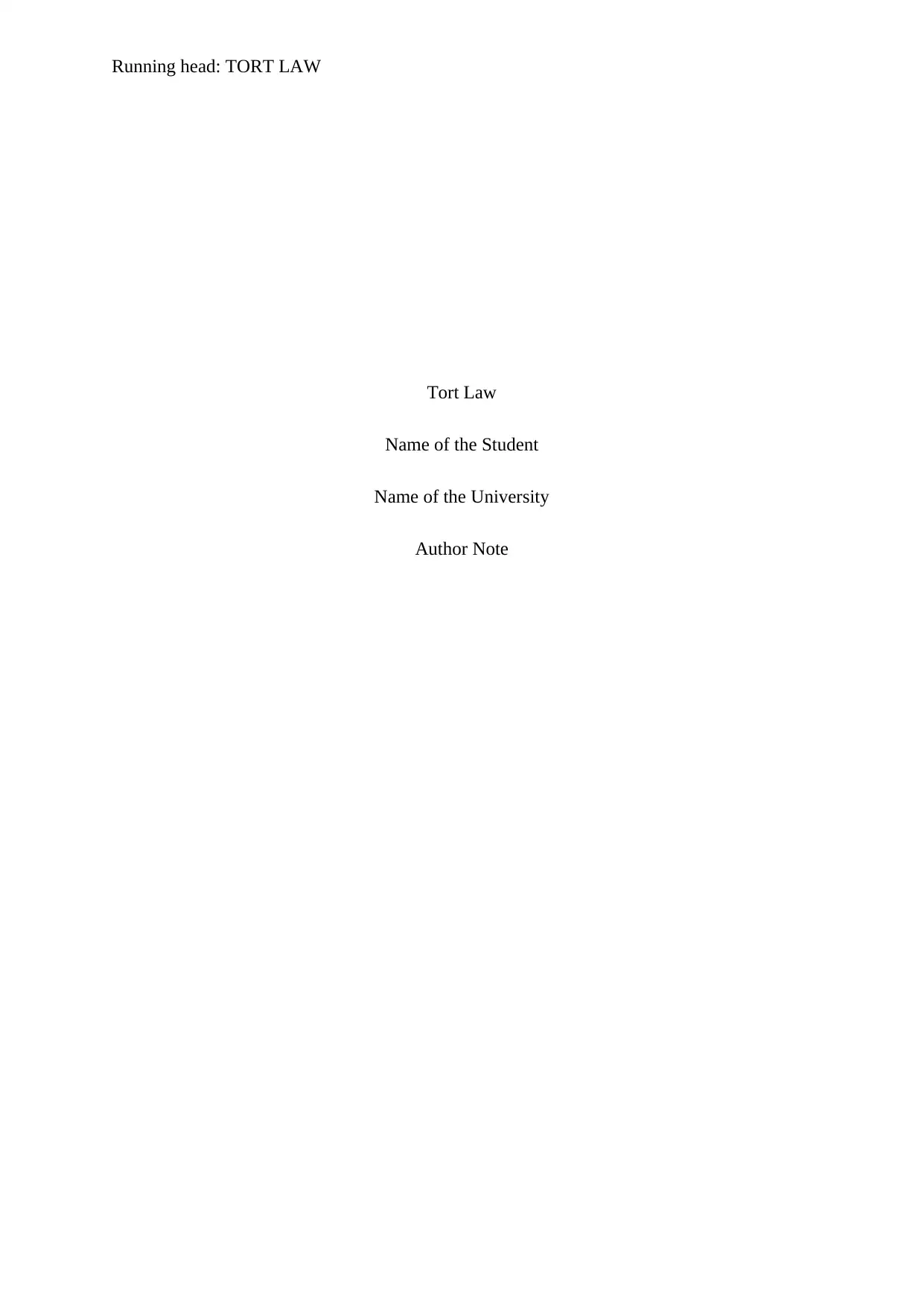
Running head: TORT LAW
Tort Law
Name of the Student
Name of the University
Author Note
Tort Law
Name of the Student
Name of the University
Author Note
Paraphrase This Document
Need a fresh take? Get an instant paraphrase of this document with our AI Paraphraser
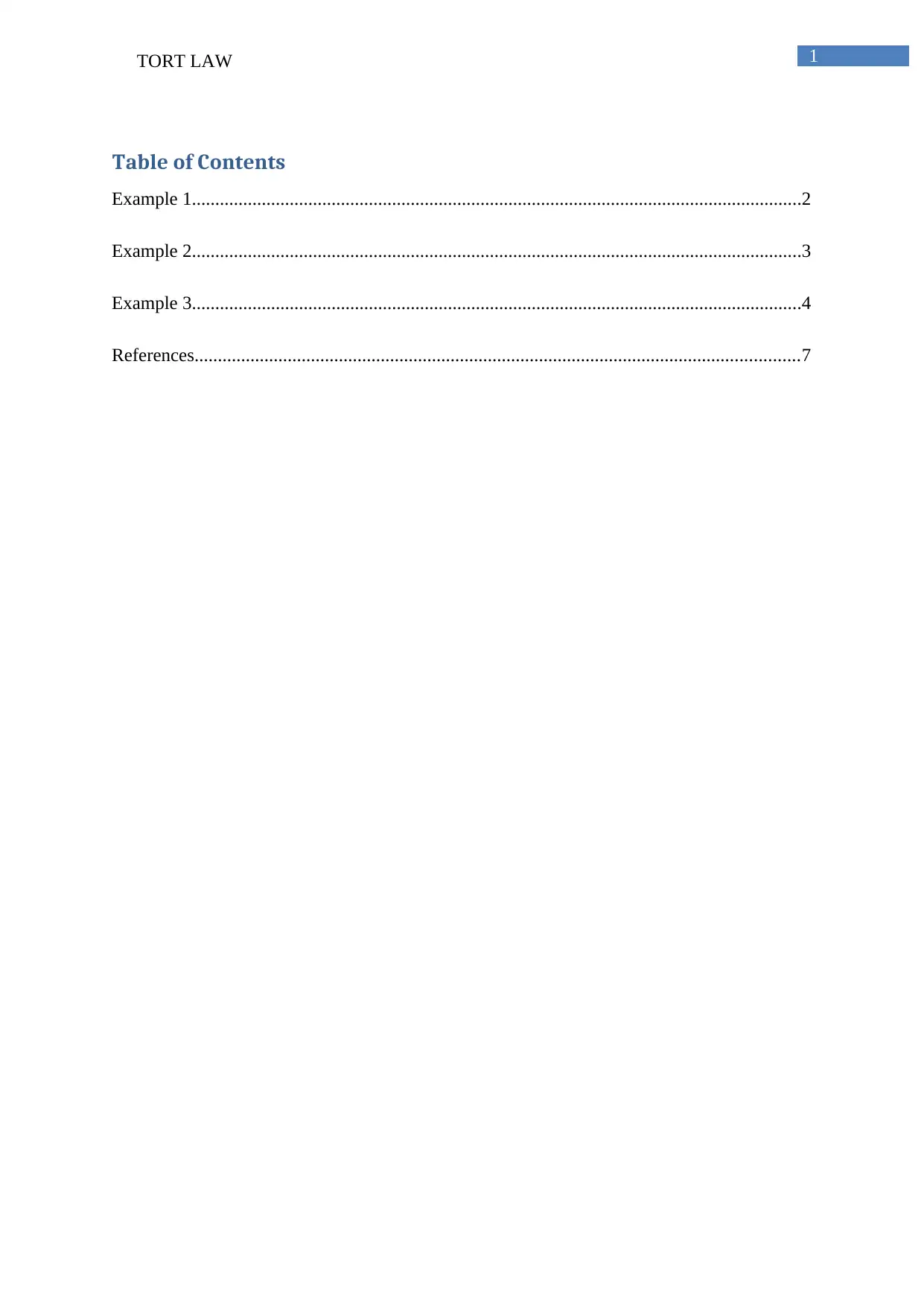
1TORT LAW
Table of Contents
Example 1...................................................................................................................................2
Example 2...................................................................................................................................3
Example 3...................................................................................................................................4
References..................................................................................................................................7
Table of Contents
Example 1...................................................................................................................................2
Example 2...................................................................................................................................3
Example 3...................................................................................................................................4
References..................................................................................................................................7
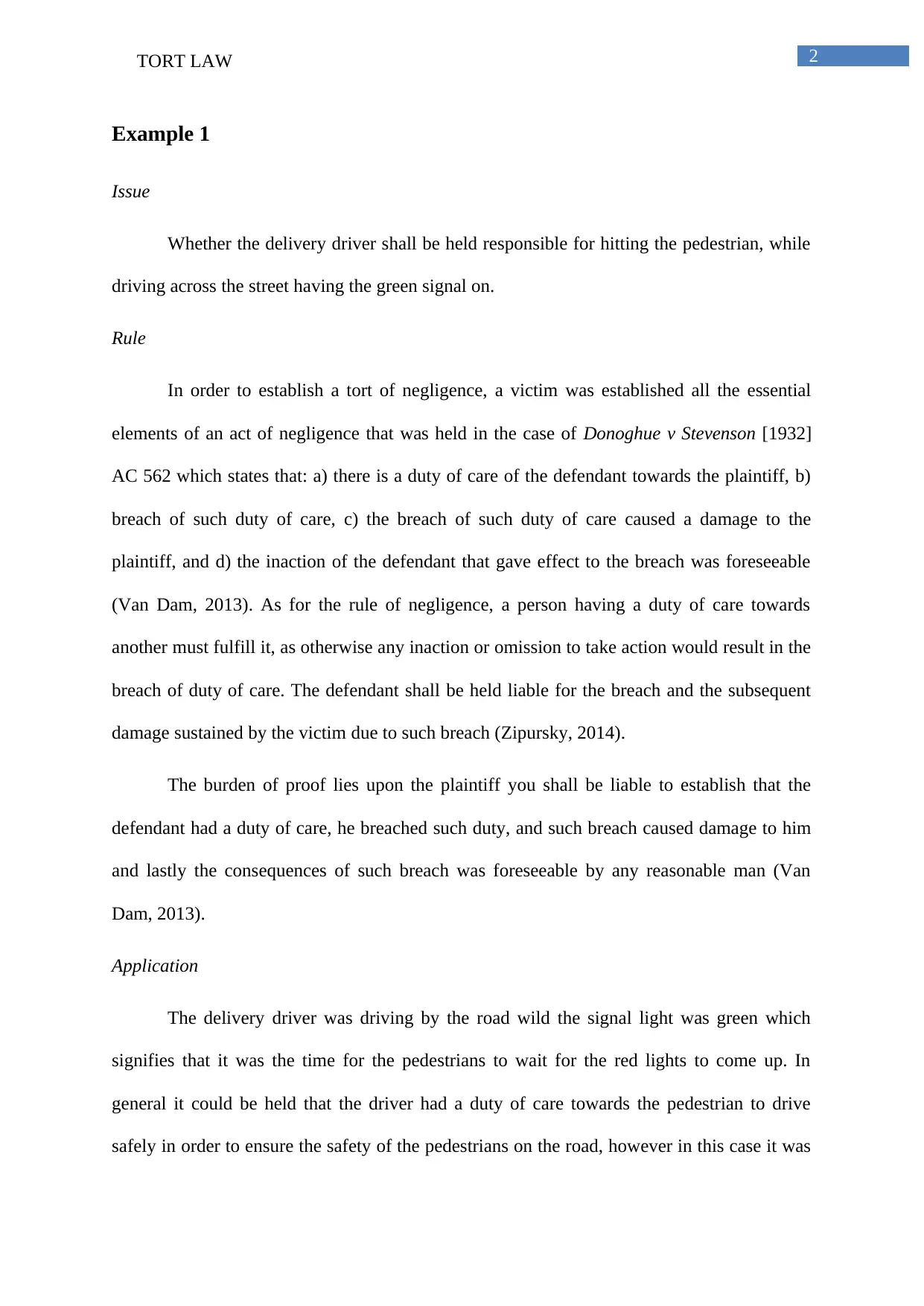
2TORT LAW
Example 1
Issue
Whether the delivery driver shall be held responsible for hitting the pedestrian, while
driving across the street having the green signal on.
Rule
In order to establish a tort of negligence, a victim was established all the essential
elements of an act of negligence that was held in the case of Donoghue v Stevenson [1932]
AC 562 which states that: a) there is a duty of care of the defendant towards the plaintiff, b)
breach of such duty of care, c) the breach of such duty of care caused a damage to the
plaintiff, and d) the inaction of the defendant that gave effect to the breach was foreseeable
(Van Dam, 2013). As for the rule of negligence, a person having a duty of care towards
another must fulfill it, as otherwise any inaction or omission to take action would result in the
breach of duty of care. The defendant shall be held liable for the breach and the subsequent
damage sustained by the victim due to such breach (Zipursky, 2014).
The burden of proof lies upon the plaintiff you shall be liable to establish that the
defendant had a duty of care, he breached such duty, and such breach caused damage to him
and lastly the consequences of such breach was foreseeable by any reasonable man (Van
Dam, 2013).
Application
The delivery driver was driving by the road wild the signal light was green which
signifies that it was the time for the pedestrians to wait for the red lights to come up. In
general it could be held that the driver had a duty of care towards the pedestrian to drive
safely in order to ensure the safety of the pedestrians on the road, however in this case it was
Example 1
Issue
Whether the delivery driver shall be held responsible for hitting the pedestrian, while
driving across the street having the green signal on.
Rule
In order to establish a tort of negligence, a victim was established all the essential
elements of an act of negligence that was held in the case of Donoghue v Stevenson [1932]
AC 562 which states that: a) there is a duty of care of the defendant towards the plaintiff, b)
breach of such duty of care, c) the breach of such duty of care caused a damage to the
plaintiff, and d) the inaction of the defendant that gave effect to the breach was foreseeable
(Van Dam, 2013). As for the rule of negligence, a person having a duty of care towards
another must fulfill it, as otherwise any inaction or omission to take action would result in the
breach of duty of care. The defendant shall be held liable for the breach and the subsequent
damage sustained by the victim due to such breach (Zipursky, 2014).
The burden of proof lies upon the plaintiff you shall be liable to establish that the
defendant had a duty of care, he breached such duty, and such breach caused damage to him
and lastly the consequences of such breach was foreseeable by any reasonable man (Van
Dam, 2013).
Application
The delivery driver was driving by the road wild the signal light was green which
signifies that it was the time for the pedestrians to wait for the red lights to come up. In
general it could be held that the driver had a duty of care towards the pedestrian to drive
safely in order to ensure the safety of the pedestrians on the road, however in this case it was
⊘ This is a preview!⊘
Do you want full access?
Subscribe today to unlock all pages.

Trusted by 1+ million students worldwide
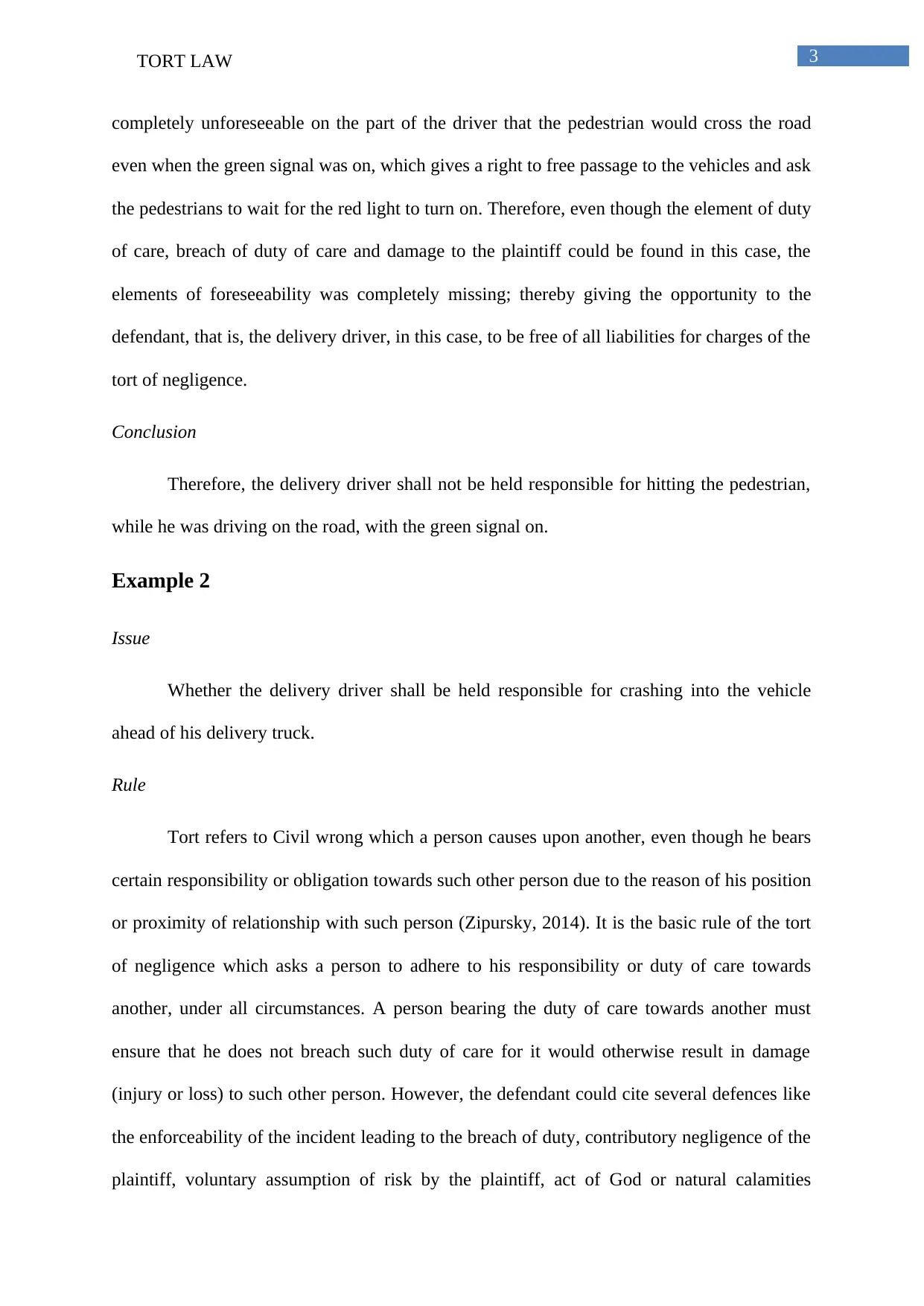
3TORT LAW
completely unforeseeable on the part of the driver that the pedestrian would cross the road
even when the green signal was on, which gives a right to free passage to the vehicles and ask
the pedestrians to wait for the red light to turn on. Therefore, even though the element of duty
of care, breach of duty of care and damage to the plaintiff could be found in this case, the
elements of foreseeability was completely missing; thereby giving the opportunity to the
defendant, that is, the delivery driver, in this case, to be free of all liabilities for charges of the
tort of negligence.
Conclusion
Therefore, the delivery driver shall not be held responsible for hitting the pedestrian,
while he was driving on the road, with the green signal on.
Example 2
Issue
Whether the delivery driver shall be held responsible for crashing into the vehicle
ahead of his delivery truck.
Rule
Tort refers to Civil wrong which a person causes upon another, even though he bears
certain responsibility or obligation towards such other person due to the reason of his position
or proximity of relationship with such person (Zipursky, 2014). It is the basic rule of the tort
of negligence which asks a person to adhere to his responsibility or duty of care towards
another, under all circumstances. A person bearing the duty of care towards another must
ensure that he does not breach such duty of care for it would otherwise result in damage
(injury or loss) to such other person. However, the defendant could cite several defences like
the enforceability of the incident leading to the breach of duty, contributory negligence of the
plaintiff, voluntary assumption of risk by the plaintiff, act of God or natural calamities
completely unforeseeable on the part of the driver that the pedestrian would cross the road
even when the green signal was on, which gives a right to free passage to the vehicles and ask
the pedestrians to wait for the red light to turn on. Therefore, even though the element of duty
of care, breach of duty of care and damage to the plaintiff could be found in this case, the
elements of foreseeability was completely missing; thereby giving the opportunity to the
defendant, that is, the delivery driver, in this case, to be free of all liabilities for charges of the
tort of negligence.
Conclusion
Therefore, the delivery driver shall not be held responsible for hitting the pedestrian,
while he was driving on the road, with the green signal on.
Example 2
Issue
Whether the delivery driver shall be held responsible for crashing into the vehicle
ahead of his delivery truck.
Rule
Tort refers to Civil wrong which a person causes upon another, even though he bears
certain responsibility or obligation towards such other person due to the reason of his position
or proximity of relationship with such person (Zipursky, 2014). It is the basic rule of the tort
of negligence which asks a person to adhere to his responsibility or duty of care towards
another, under all circumstances. A person bearing the duty of care towards another must
ensure that he does not breach such duty of care for it would otherwise result in damage
(injury or loss) to such other person. However, the defendant could cite several defences like
the enforceability of the incident leading to the breach of duty, contributory negligence of the
plaintiff, voluntary assumption of risk by the plaintiff, act of God or natural calamities
Paraphrase This Document
Need a fresh take? Get an instant paraphrase of this document with our AI Paraphraser
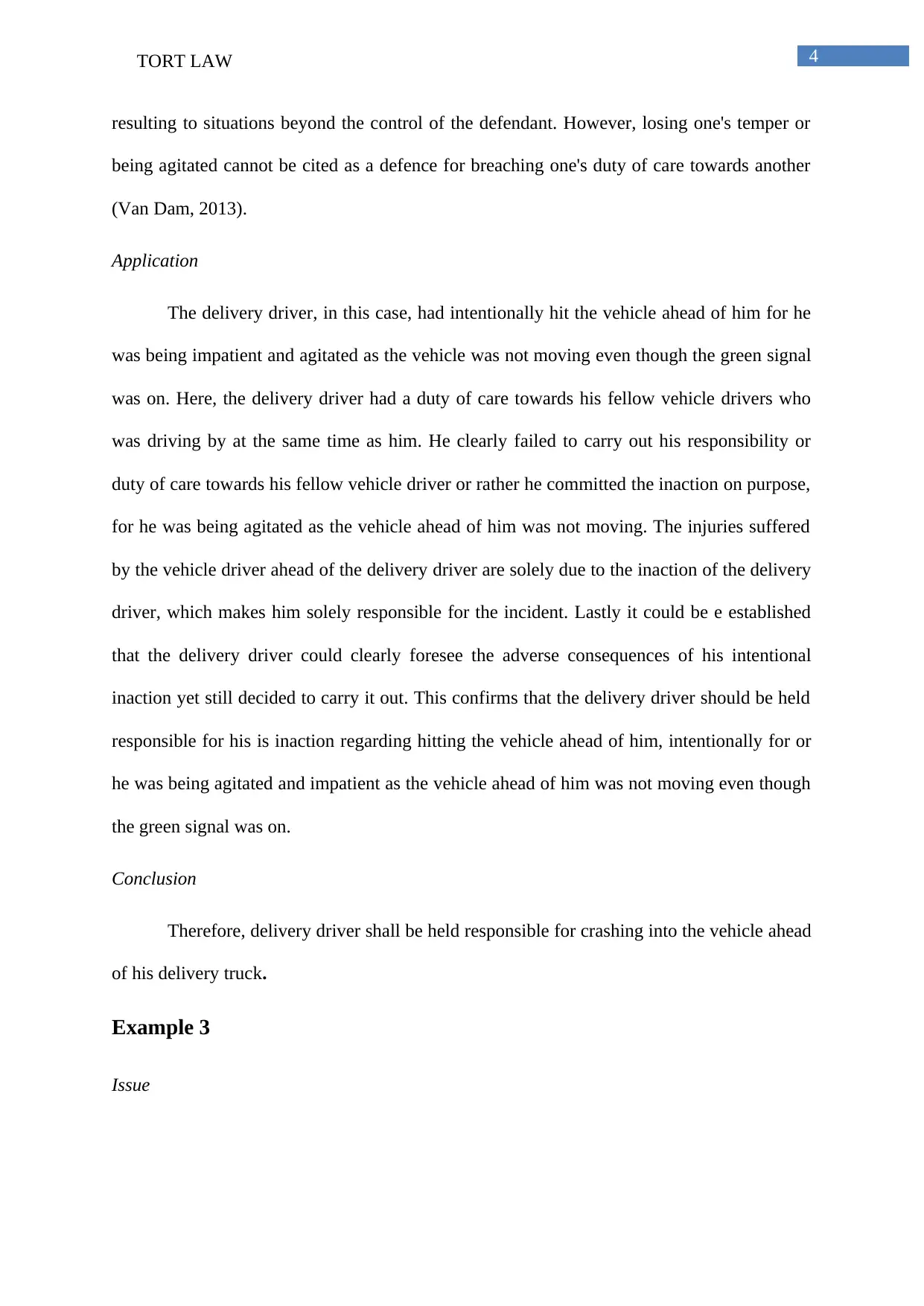
4TORT LAW
resulting to situations beyond the control of the defendant. However, losing one's temper or
being agitated cannot be cited as a defence for breaching one's duty of care towards another
(Van Dam, 2013).
Application
The delivery driver, in this case, had intentionally hit the vehicle ahead of him for he
was being impatient and agitated as the vehicle was not moving even though the green signal
was on. Here, the delivery driver had a duty of care towards his fellow vehicle drivers who
was driving by at the same time as him. He clearly failed to carry out his responsibility or
duty of care towards his fellow vehicle driver or rather he committed the inaction on purpose,
for he was being agitated as the vehicle ahead of him was not moving. The injuries suffered
by the vehicle driver ahead of the delivery driver are solely due to the inaction of the delivery
driver, which makes him solely responsible for the incident. Lastly it could be e established
that the delivery driver could clearly foresee the adverse consequences of his intentional
inaction yet still decided to carry it out. This confirms that the delivery driver should be held
responsible for his is inaction regarding hitting the vehicle ahead of him, intentionally for or
he was being agitated and impatient as the vehicle ahead of him was not moving even though
the green signal was on.
Conclusion
Therefore, delivery driver shall be held responsible for crashing into the vehicle ahead
of his delivery truck.
Example 3
Issue
resulting to situations beyond the control of the defendant. However, losing one's temper or
being agitated cannot be cited as a defence for breaching one's duty of care towards another
(Van Dam, 2013).
Application
The delivery driver, in this case, had intentionally hit the vehicle ahead of him for he
was being impatient and agitated as the vehicle was not moving even though the green signal
was on. Here, the delivery driver had a duty of care towards his fellow vehicle drivers who
was driving by at the same time as him. He clearly failed to carry out his responsibility or
duty of care towards his fellow vehicle driver or rather he committed the inaction on purpose,
for he was being agitated as the vehicle ahead of him was not moving. The injuries suffered
by the vehicle driver ahead of the delivery driver are solely due to the inaction of the delivery
driver, which makes him solely responsible for the incident. Lastly it could be e established
that the delivery driver could clearly foresee the adverse consequences of his intentional
inaction yet still decided to carry it out. This confirms that the delivery driver should be held
responsible for his is inaction regarding hitting the vehicle ahead of him, intentionally for or
he was being agitated and impatient as the vehicle ahead of him was not moving even though
the green signal was on.
Conclusion
Therefore, delivery driver shall be held responsible for crashing into the vehicle ahead
of his delivery truck.
Example 3
Issue
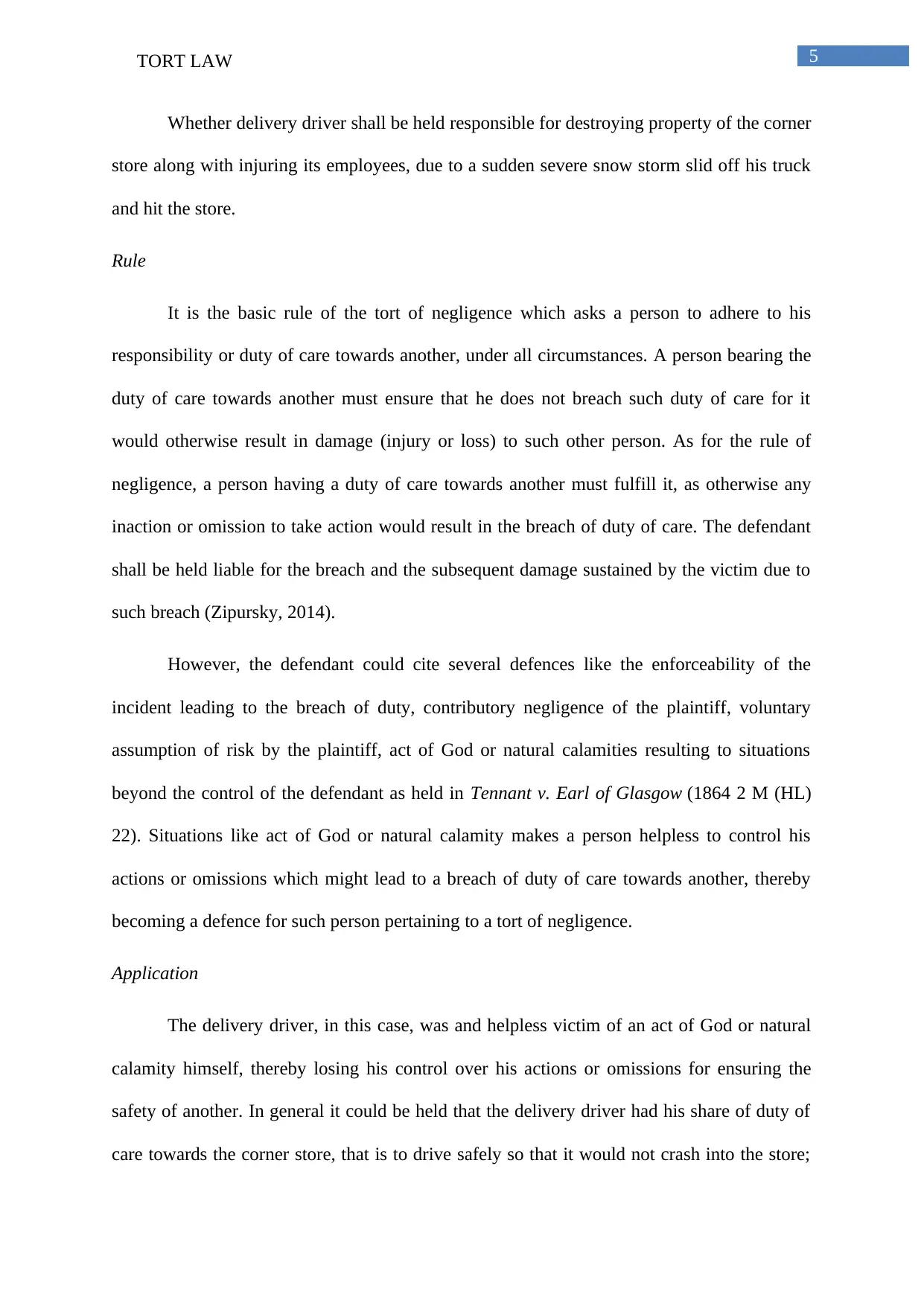
5TORT LAW
Whether delivery driver shall be held responsible for destroying property of the corner
store along with injuring its employees, due to a sudden severe snow storm slid off his truck
and hit the store.
Rule
It is the basic rule of the tort of negligence which asks a person to adhere to his
responsibility or duty of care towards another, under all circumstances. A person bearing the
duty of care towards another must ensure that he does not breach such duty of care for it
would otherwise result in damage (injury or loss) to such other person. As for the rule of
negligence, a person having a duty of care towards another must fulfill it, as otherwise any
inaction or omission to take action would result in the breach of duty of care. The defendant
shall be held liable for the breach and the subsequent damage sustained by the victim due to
such breach (Zipursky, 2014).
However, the defendant could cite several defences like the enforceability of the
incident leading to the breach of duty, contributory negligence of the plaintiff, voluntary
assumption of risk by the plaintiff, act of God or natural calamities resulting to situations
beyond the control of the defendant as held in Tennant v. Earl of Glasgow (1864 2 M (HL)
22). Situations like act of God or natural calamity makes a person helpless to control his
actions or omissions which might lead to a breach of duty of care towards another, thereby
becoming a defence for such person pertaining to a tort of negligence.
Application
The delivery driver, in this case, was and helpless victim of an act of God or natural
calamity himself, thereby losing his control over his actions or omissions for ensuring the
safety of another. In general it could be held that the delivery driver had his share of duty of
care towards the corner store, that is to drive safely so that it would not crash into the store;
Whether delivery driver shall be held responsible for destroying property of the corner
store along with injuring its employees, due to a sudden severe snow storm slid off his truck
and hit the store.
Rule
It is the basic rule of the tort of negligence which asks a person to adhere to his
responsibility or duty of care towards another, under all circumstances. A person bearing the
duty of care towards another must ensure that he does not breach such duty of care for it
would otherwise result in damage (injury or loss) to such other person. As for the rule of
negligence, a person having a duty of care towards another must fulfill it, as otherwise any
inaction or omission to take action would result in the breach of duty of care. The defendant
shall be held liable for the breach and the subsequent damage sustained by the victim due to
such breach (Zipursky, 2014).
However, the defendant could cite several defences like the enforceability of the
incident leading to the breach of duty, contributory negligence of the plaintiff, voluntary
assumption of risk by the plaintiff, act of God or natural calamities resulting to situations
beyond the control of the defendant as held in Tennant v. Earl of Glasgow (1864 2 M (HL)
22). Situations like act of God or natural calamity makes a person helpless to control his
actions or omissions which might lead to a breach of duty of care towards another, thereby
becoming a defence for such person pertaining to a tort of negligence.
Application
The delivery driver, in this case, was and helpless victim of an act of God or natural
calamity himself, thereby losing his control over his actions or omissions for ensuring the
safety of another. In general it could be held that the delivery driver had his share of duty of
care towards the corner store, that is to drive safely so that it would not crash into the store;
⊘ This is a preview!⊘
Do you want full access?
Subscribe today to unlock all pages.

Trusted by 1+ million students worldwide
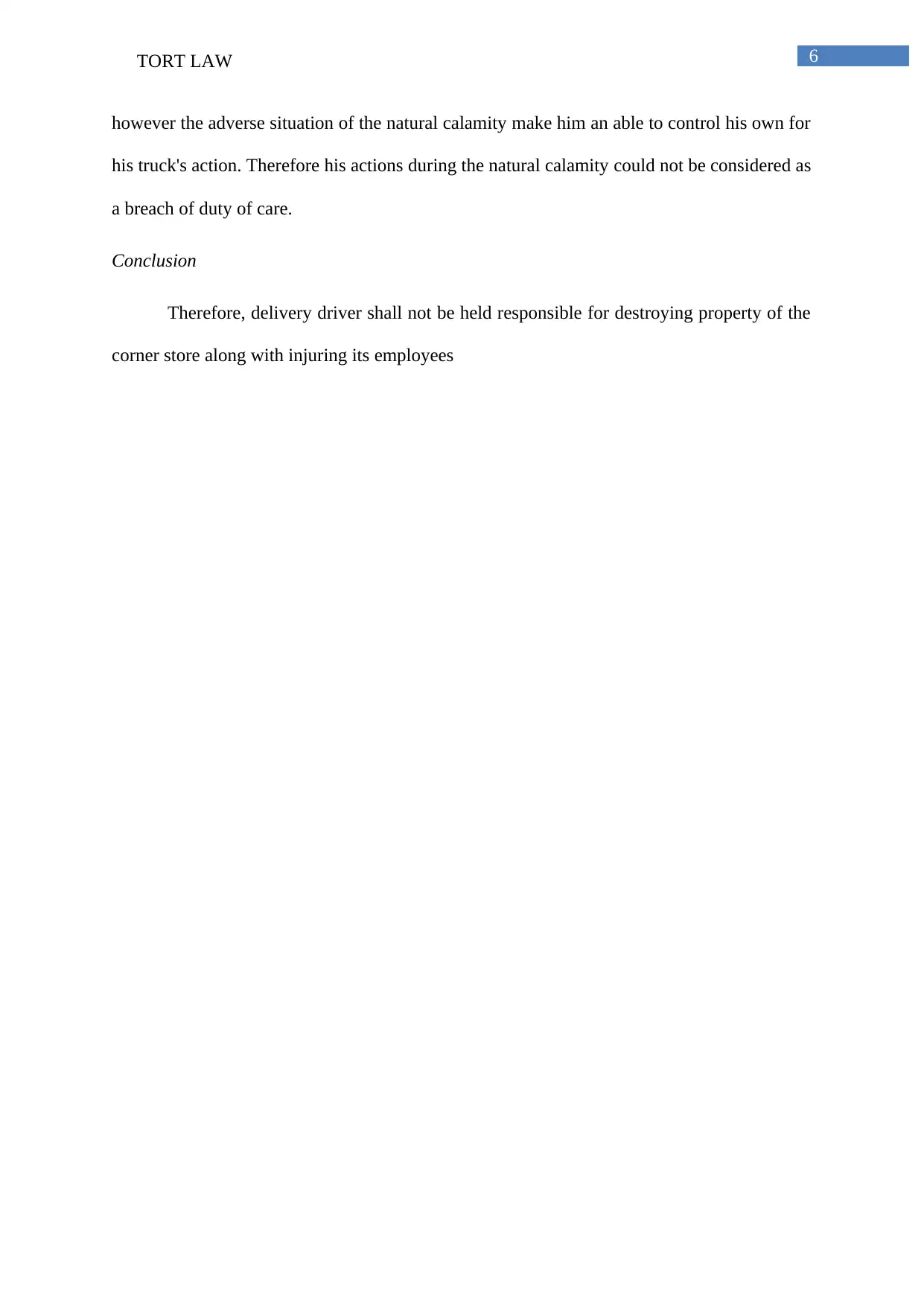
6TORT LAW
however the adverse situation of the natural calamity make him an able to control his own for
his truck's action. Therefore his actions during the natural calamity could not be considered as
a breach of duty of care.
Conclusion
Therefore, delivery driver shall not be held responsible for destroying property of the
corner store along with injuring its employees
however the adverse situation of the natural calamity make him an able to control his own for
his truck's action. Therefore his actions during the natural calamity could not be considered as
a breach of duty of care.
Conclusion
Therefore, delivery driver shall not be held responsible for destroying property of the
corner store along with injuring its employees
Paraphrase This Document
Need a fresh take? Get an instant paraphrase of this document with our AI Paraphraser
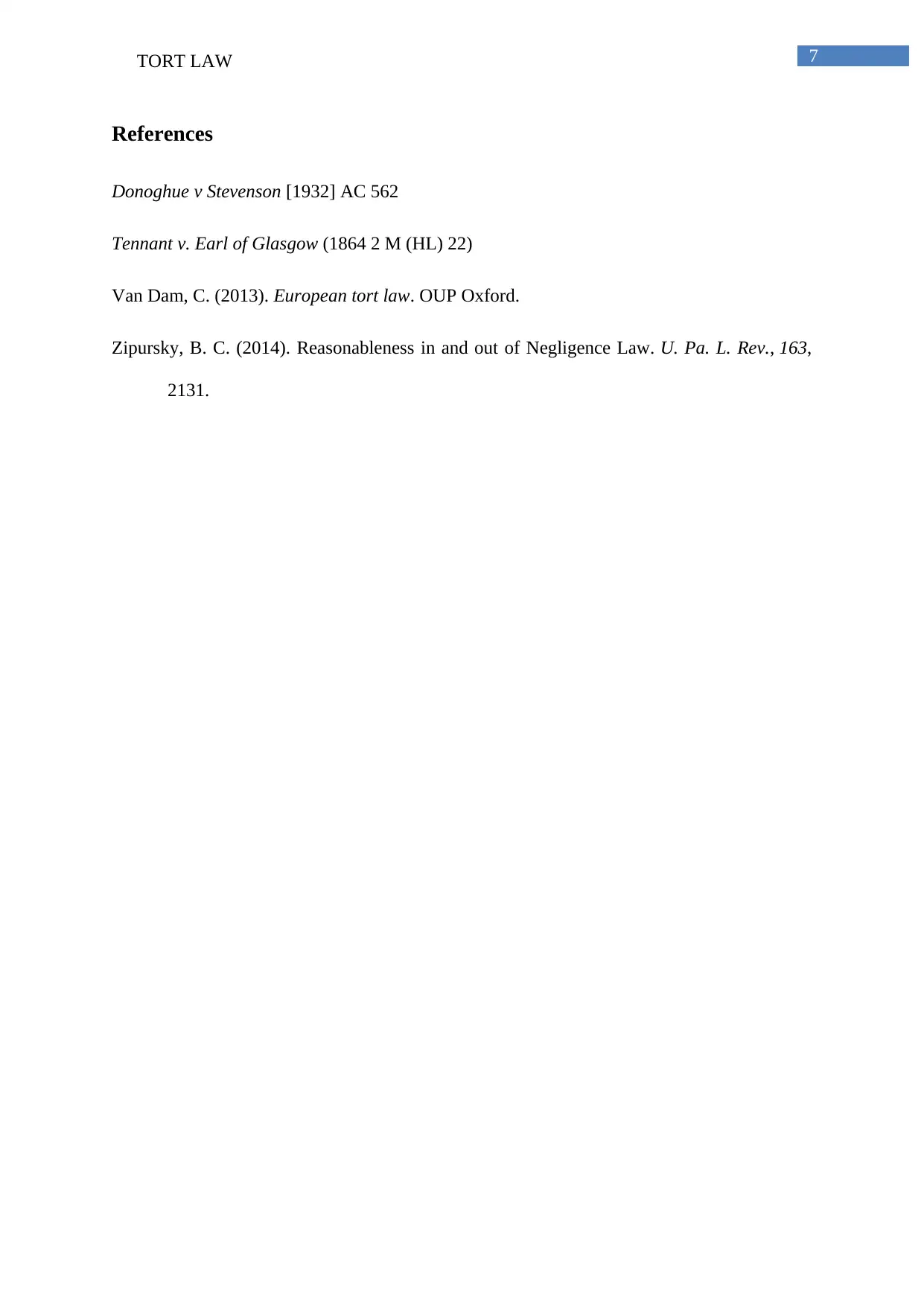
7TORT LAW
References
Donoghue v Stevenson [1932] AC 562
Tennant v. Earl of Glasgow (1864 2 M (HL) 22)
Van Dam, C. (2013). European tort law. OUP Oxford.
Zipursky, B. C. (2014). Reasonableness in and out of Negligence Law. U. Pa. L. Rev., 163,
2131.
References
Donoghue v Stevenson [1932] AC 562
Tennant v. Earl of Glasgow (1864 2 M (HL) 22)
Van Dam, C. (2013). European tort law. OUP Oxford.
Zipursky, B. C. (2014). Reasonableness in and out of Negligence Law. U. Pa. L. Rev., 163,
2131.
1 out of 8
Related Documents
Your All-in-One AI-Powered Toolkit for Academic Success.
+13062052269
info@desklib.com
Available 24*7 on WhatsApp / Email
![[object Object]](/_next/static/media/star-bottom.7253800d.svg)
Unlock your academic potential
Copyright © 2020–2025 A2Z Services. All Rights Reserved. Developed and managed by ZUCOL.





